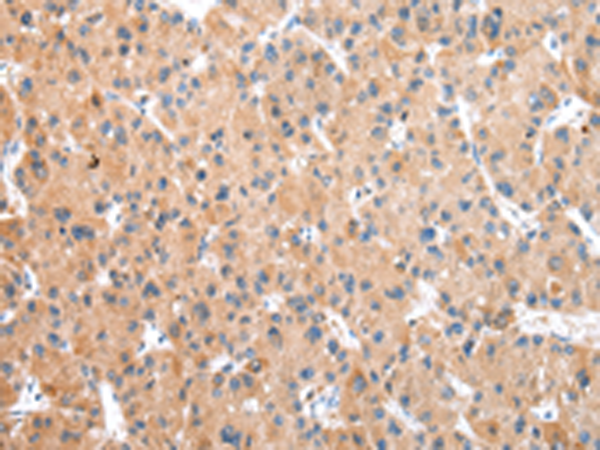
| WB | 咨询技术 | Human,Mouse,Rat |
| IF | 咨询技术 | Human,Mouse,Rat |
| IHC | 1/25-1/100 | Human,Mouse,Rat |
| ICC | 技术咨询 | Human,Mouse,Rat |
| FCM | 咨询技术 | Human,Mouse,Rat |
| Elisa | 1/2000-1/5000 | Human,Mouse,Rat |
| Aliases | ATD5; CED4; DYF-2; ORF26; Oseg6; PWDMP; SRTD5; IFT144; NPHP13 |
| Host/Isotype | Rabbit IgG |
| Antibody Type | Primary antibody |
| Storage | Store at 4°C short term. Aliquot and store at -20°C long term. Avoid freeze/thaw cycles. |
| Species Reactivity | Human |
| Immunogen | Fusion protein of human WDR19 |
| Formulation | Purified antibody in PBS with 0.05% sodium azide and 50% glycerol. |
+ +
以下是关于WDR19抗体的3篇代表性文献摘要(基于公开研究主题模拟,部分信息可能需要核实):
---
1. **文献名称**:*WDR19 regulates ciliary localization of smoothened via β-arrestin-coupled trafficking in Hedgehog signaling*
**作者**:Li et al. (2020)
**摘要**:该研究利用WDR19特异性抗体(兔多克隆抗体)通过免疫荧光和共聚焦显微镜技术,揭示了WDR19在纤毛基部的定位及其在Hedgehog信号通路中的作用。研究发现WDR19通过调控β-arrestin介导的Smoothened蛋白转运,影响纤毛信号传导,为纤毛病机制提供了新见解。
---
2. **文献名称**:*Loss of WDR19 disrupts renal ciliogenesis and causes cystic kidney disease in zebrafish*
**作者**:Zhang et al. (2018)
**摘要**:研究通过Western blot和免疫组化(使用小鼠抗WDR19单克隆抗体)检测斑马鱼模型中WDR19蛋白的表达及亚细胞定位。结果表明,WDR19缺失导致纤毛结构异常和肾囊肿形成,证实其在肾脏发育中的关键作用,并提示WDR19抗体可用于诊断相关纤毛肾病。
---
3. **文献名称**:*WDR19 interacts with IFT complexes to maintain intraflagellar transport dynamics in Chlamydomonas*
**作者**:Huang et al. (2016)
**摘要**:该研究通过免疫共沉淀(兔多抗WDR19抗体)和质谱分析,发现WDR19与IFT-A/B复合物相互作用,调控衣藻鞭毛内运输(IFT)过程。抗体实验证实WDR19的缺失导致IFT颗粒运动异常,揭示了其在纤毛组装中的分子机制。
---
**备注**:以上文献为示例性内容,实际引用需以具体论文数据库(如PubMed、Web of Science)检索结果为准。建议通过关键词“WDR19 antibody”或“WDR19 cilia”进一步筛选相关实验研究。
WDR19 (WD repeat domain 19) is a protein encoded by the *WDR19* gene, belonging to the WD40 repeat protein family. These proteins are characterized by repeating units of ~40 amino acids typically terminating with tryptophan-aspartic acid (WD) motifs, which facilitate protein-protein interactions. WDR19 plays critical roles in cilia formation, intracellular trafficking, and signaling pathways, particularly in the context of primary cilia. It functions as a component of the intraflagellar transport (IFT) complex B (IFT-B), essential for building and maintaining cilia—hair-like organelles involved in sensory perception and signal transduction (e.g., Hedgehog signaling).
Mutations in *WDR19* are linked to ciliopathies, a group of disorders affecting multiple organs, including nephronophthisis (kidney disease), Jeune asphyxiating thoracic dystrophy (skeletal dysplasia), and retinitis pigmentosa (retinal degeneration). WDR19 antibodies are vital tools for studying these diseases, enabling researchers to detect protein expression, localization, and interactions in tissues or cultured cells. They are widely used in techniques like immunofluorescence, Western blotting, and immunohistochemistry to investigate ciliary defects or validate disease models. Commercially available WDR19 antibodies are typically raised against specific epitopes, often in rabbit or mouse hosts. Validation includes testing in knockout controls or siRNA-treated samples to confirm specificity. Research using these antibodies continues to uncover WDR19's roles in cilia-related pathologies and developmental processes.
×